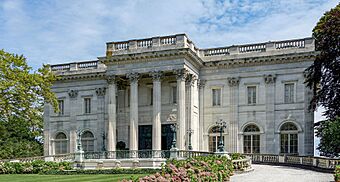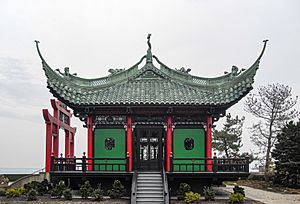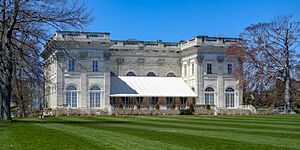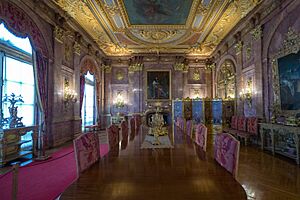Marble House facts for kids
|
Marble House
|
|
|
U.S. National Historic Landmark District
Contributing Property |
|

The western facade, facing Bellevue Avenue
|
|
| Location | 596 Bellevue Avenue Newport, Rhode Island |
|---|---|
| Built | 1888–92 |
| Architect | Richard Morris Hunt |
| Architectural style | Beaux Arts |
| Part of | Bellevue Avenue Historic District (ID72000023) |
| NRHP reference No. | 71000025 |
Quick facts for kids Significant dates |
|
| Added to NRHP | September 10, 1971 |
| Designated NHL | February 17, 2006 |
| Designated NHLDCP | December 8, 1972 |
Marble House is a huge, fancy home in Newport, Rhode Island. It was built between 1888 and 1892 for a very rich couple, Alva and William Kissam Vanderbilt. They used it as a summer "cottage," even though it was more like a palace!
The house was designed by a famous architect named Richard Morris Hunt. He used a style called Beaux Arts, which was popular in France. When it was finished in 1892, Marble House was one of the most luxurious homes in America. Its grand entrance even looked a bit like the White House.
Today, Marble House is a museum. It was added to the National Register of Historic Places in 1971. Later, in 2006, it became a National Historic Landmark. This means it's a very important historical place. The Newport Preservation Society now takes care of it and lets people visit.
Contents
History of Marble House
Building a Grand Summer Home
Marble House was built as a summer "cottage" for Alva and William Kissam Vanderbilt. It took four years to build, from 1888 to 1892. This mansion helped change Newport from a quiet summer town to a place known for its huge, fancy stone houses.
The house has 50 rooms and needed 36 servants to run it. These servants included butlers, maids, and coachmen. Building Marble House cost a lot of money. About $7 million was spent just on the marble!
William's older brother, Cornelius Vanderbilt II, later built an even bigger house nearby. It was called The Breakers.
Alva Vanderbilt's Life at Marble House
Alva Vanderbilt became the full owner of Marble House in 1895. She received it as a birthday gift. After she remarried in 1896, she moved to another mansion nearby.
Later, Alva reopened Marble House. She added a special building called the Chinese Tea House. It was built on the cliff overlooking the ocean. Alva used this tea house to hold meetings and rallies. She was a strong supporter of women's right to vote.
In 1919, Alva Belmont closed Marble House for good. She moved to France to be closer to her daughter. She sold the house in 1932 to Frederick H. Prince.
Preserving the Mansion
The Prince family lived in Marble House during the summers for over 30 years. They were careful to keep the inside of the house just as the Vanderbilts had designed it. They mostly stayed in smaller rooms on the third floor, which used to be for servants.
In 1957, a famous party called the Tiffany Ball was held at Marble House. Many important guests attended, including John F. Kennedy and his wife, Jacqueline. This party helped raise money for the Preservation Society of Newport County.
In 1963, the Preservation Society bought Marble House. Funding came from Harold Stirling Vanderbilt, the youngest son of Alva and William. The Prince family also gave almost all the original furniture to the Society.
Marble House Today
Marble House is still in great condition. It is a very popular place for tourists in Newport, Rhode Island. Visitors can take guided tours or explore on their own. The mansion also hosts special events, parties, and weddings.
The Vanderbilts also had a large carriage house built across the street. This building is now privately owned and used as a home.
Design and Architecture
Marble House is one of the first examples of Beaux-Arts architecture in the United States. Its design was inspired by a smaller palace in France called the Petit Trianon at the Palace of Versailles.
The inside of Marble House was designed by a French company called Jules Allard and Sons. The gardens were designed by Ernest W. Bowditch.
Outside the Mansion
The mansion looks like it has two floors, but it actually has four! The kitchen and service areas are in the basement. The main reception rooms are on the ground floor. Bedrooms are on the second floor. And the servants' rooms are hidden on the third floor.
The outside walls are made of white marble from Westchester. The architect, Richard Morris Hunt, designed them to look like old French buildings.
The front of the house has tall, fancy columns. A curved marble ramp leads up to the entrance. This ramp has a fountain with interesting masks that spout water. The back of the house faces the Atlantic Ocean. It has a marble terrace with a beautiful railing.
Inside the Mansion
When you enter Marble House, you go through two huge French-style doors. Each door weighs one and a half tons! They have the letters "WV" for William Vanderbilt.
The Stair Hall is a two-story room with yellow marble walls and a grand staircase. The staircase railing is made of iron and bronze, inspired by the Palace of Versailles. The ceiling has an old painting from Venice showing gods and goddesses.
The Grand Salon was used for parties and receptions. It is decorated in a fancy French style with green silk and gold panels. These panels show scenes from old stories. The ceiling has an 18th-century French painting of the goddess Minerva.
The Gothic Room was designed to show off Alva Vanderbilt's collection of old art and objects. It has a stone fireplace copied from a famous house in France.
The Library is a cozy room in the Rococo style. It was used for reading and as a morning room. The Dining Room is very grand, with pink marble and gold decorations. Its fireplace is a copy of one at Versailles.
Mrs. Vanderbilt's Bedroom, on the second floor, is also in a French style. Its ceiling has a circular painting of the goddess Athena. This painting is very old, from around 1721.
Filming Location
Marble House has been used as a setting for several movies and TV shows. You might have seen its beautiful rooms in:
- The 1974 film, The Great Gatsby
- The 1995 miniseries The Buccaneers
- The 1997 film Amistad
- The 2008 film 27 Dresses
Even Victoria's Secret filmed one of their holiday commercials here in 2012!
Gallery
See also
 In Spanish: Marble House para niños
In Spanish: Marble House para niños










